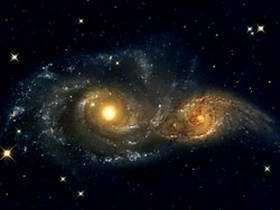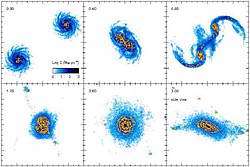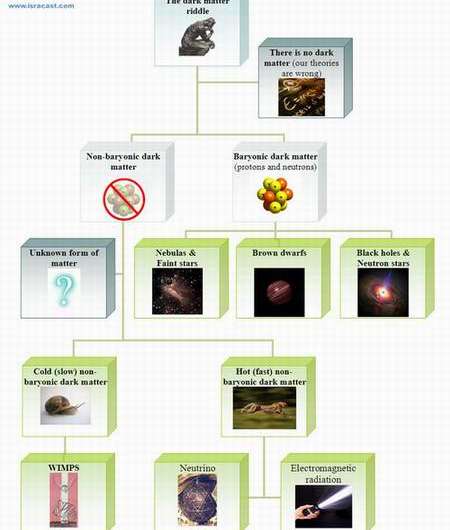Dark Matter – One Mystery Solved (Update)

Until recently cosmologists could not explain why elliptical galaxies did not appear to have dark matter haloes surrounding them, which is known to exist in other types of galaxies. Analyzing data from a simulation performed on one of the most advanced supercomputers in the world, an Israeli cosmologist showed that the existing model of elliptical galaxies was wrong, proving that dark matter was there all along.
Image: Collusion of two spiral gallaxies.
The research that started the debate was published in 2003 in the journal Science by Aaron J. Romanowsky and his colleagues. In that article Romanowsky claimed that he found a surprising fact: dark matter, which is thought to be surrounding galaxies across the universe, is absent from one type of galaxy known as an “elliptical" (or rounded) galaxy. Romanowsky's research puzzled physicists since, until that time, it was commonly thought that dark matter surrounds every galaxy in the universe and causes the further stars in each galaxy to move much faster then they would have normally.
Avishai Dekel, Professor of Physics at the Hebrew University in Jerusalem, decided to address this cosmological puzzle. Drawing on highly advanced computer simulations he was able to calculate that, contrary to the 2003 paper, the stars in the outskirts of elliptical galaxies do not move slower than those in spiral galaxies. This suggests the existence of dark matter haloes surrounding elliptical galaxies similar to those surrounding spiral galaxies.
The reason why Romanowsky and his team believed elliptical galaxies do not posses dark matter haloes was because of observations which showed a slow movement of stars at the outskirts of elliptical galaxies contrary to the fast moving stars at the outskirts of spiral galaxies. The velocity of distant stars is measured using an effect called red shift (the reddening of light from a star that is moving away from us). The limitation of this method is that it is only possible to measure the component of velocity which is along the observer's line of sight.

Image right: Super-computer simulation of two spiral galaxies colliding (Credit: arXiv.org)
This limitation would not be a problem if the orbits of the observed stars in the elliptical galaxies were randomly oriented with respect to the line of sight, as it was commonly assumed. However, the analysis performed by Professor Dekel and his team showed that the stars in elliptical galaxies that are farthest from the center are likely to be moving in elongated, eccentric orbits in such a way that most of their motion is perpendicular to the line of sight. Therefore, they could be moving at high velocities without exhibiting much motion toward or away from the observers.
This phenomenon is the result of the way elliptical galaxies are formed as a violent merger of two spiral galaxies. ''In the merger process that produces these galaxies, a lot of the stars get flung out to fairly large distances, and they end up in highly elongated orbits that take them far away and then back, close to the center,'' explains Dekel.
Professor Dekel's research was based on simulations carried out by fellow researchers
at the University of California, Santa Cruz. The simulations were conducted using the third fastest supercomputer in the world – the NASA Columbia supercomputer – which became operational in 2004. The Colombia supercomputer is built with 10,240 Intel Itanium® 2 processors running at 1.5 gigahertz each with 20 terabytes of shared memory and 10 petabytes (10 million gigabytes) of shared storage space. This behemoth was used to calculate the violent collision and merger of the spiral galaxies that lead to the formation of the elliptical galaxies.
The History of dark matter theory
The existence of dark matter was first suggested in the early 1930's by the Swiss physicist Fritz Zwicky who calculated that the radial velocities of eight galaxies was 400 times greater than that expected by the shared gravity of luminous matter in those galaxies. The explanation given by Zwicky to his extraordinary find was to suggest the existence of what he called "dark matter", or matter which cannot be directly observed but can be inferred indirectly by its gravitational influence on visible matter. Analogously, imagine a caveman, who never saw a modern city, looking at New York at night. Naturally he will assume that New York is just a collection of light sources since all he can see is a variety of bright dots. Just like New York, space has much more then meets the eye.

Image above: Dark Matter candidates. Click here to enlarge
Since the 1930's more and more evidence accumulated in support of the dark matter theory. Since the 1970's several different explanations were suggested by physicists in order to explain the nature of dark matter. One suggestion was that dark matter is basically just a large amount of ordinary matter also called Baryonic matter which consists of protons and neutrons. Various forms of Baryonic matter were suggested in order to account for the dark matter in the universe: black holes, neutron stars, brown dwarfs and even planets were all possible candidates. But a more intriguing option for the missing matter in the universe was also suggest by physicists – Non-Baryonic matter. Two distinct forms of Non-Baryonic matter were proposed – hot Non-Baryonic matter and cold Non-Baryonic matter. Hot Non-Baryonic matter is made of particles moving very fast, such as neutrinos, cold Non-Baryonic matter is possibly composed of what is known as WIMPS or weakly interacting massive particles.
In 2001 NASA launched the Wilkinson Microwave Anisotropy Probe (WMAP). Apart from calculating the age and size of the universe more accurately than ever before, WMAP also helped scientists to understand the composition of the universe more clearly and its findings only served to aggravate the already problematic dark matter question. WMAP discovered (with about 5% margin of error) that the universe is composed of 4% ordinary matter, 23% of an unknown type of dark matter, and 73% of an even more mysterious dark energy.
by Iddo Genuth - IsraCast
The original story can be found here.
For any comments about this story, please contact the writer of the original article.
© 2005 IsraCast. Published with permission of Iddo Genuth















